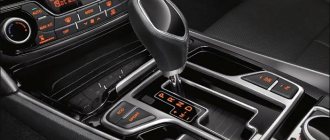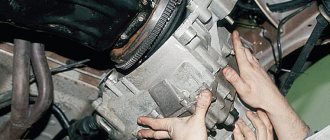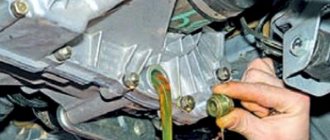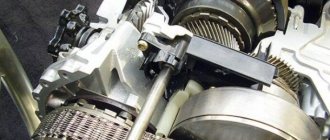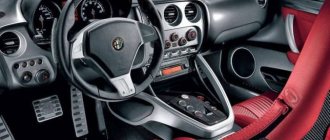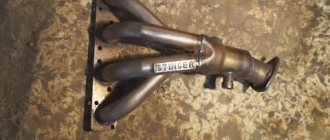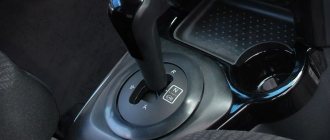In the middle of the last century, CVTs, as a rule, could only be seen on scooters or mopeds.
Today, improved types of transmission devices can be installed on almost any car, which is what many manufacturers do. And this greatly complicates the choice for a simple car enthusiast.
CVT and automatic gearboxes are increasingly on the scales; what is the difference between automatic devices and which one should you choose? In this article we will try to sort out this and other issues related to the CVT and automatic transmission.
Design and operation of the variator
The variator structurally consists of:
- driving/driven pulleys, shafts;
- steel belt;
- starting clutch (centrifugal, multi-disc, electromagnetic, torque converter);
- planetary gear satellite;
- oil pump;
- bearings;
- hydraulic unit;
- crankcase with magnets for filling transmission fluid;
- differential;
- planetary gearbox.
There are several types of variators. The most common among them is the V-belt mechanism. The pulleys in it consist of 2 cone-shaped disks with a slope towards the shaft axis. When moving, they are able to move or move apart.
A metal belt consisting of pushing segments is stretched and clamped between the halves of the variator pulleys (they create rotation by clinging to the body of the cones with a toothed surface). When the pulleys move apart, the belt goes inward, and when brought closer it takes on the shape of a wedge. The gear ratio changes by increasing or decreasing the diameters of the conical disks.
At the beginning of the movement, the cones of the driving pulley diverge, and the cones of the driven pulley converge. As speed increases, the reverse process occurs. As a result, the gear ratio changes downward, the traction force decreases, and the speed on the driven shaft increases.
The software part processes the information and changes the operating mode of the CVT variator. The differential distributes torque to the driving wheels of the car. The oil sump serves as a support and protection for the working mechanisms and is used to store transmission fluid, without timely replacement of which the variator will not last long.
By what signs can you determine that the variator has failed?
Signs of main variator failures:
slipping or inability to move away - malfunctions in the variator control module, a defect in the variator transmission (belt slipping between the pulley cones), malfunction of the torque converter, main drive clutch, electro-hydraulic system;
jumps and jerks during operation - the oil pump pressure relief valve is jammed;
stopping the car - wear on the torque converter pump wheel;
the car is moving in neutral - defects in the electrical wiring, gear selector, variator control module;
A hum unusual for a vehicle is the wear of the cone bearings.
The service life of a CVT variator depends on correct operation and regular maintenance. Manufacturers of CVT transmissions recommend changing the belt and transmission fluid in a timely manner (on average after 40 thousand kilometers).
We invite you to watch a video tip on how to operate a variator.
If you have no experience in solving problems with a variator, you can contact the “Cvariator Repair Center No. 1”. Our specialists will help you diagnose and fix problems in a short time. You can get additional information by calling: Moscow –, St. Petersburg – 8. We accept calls from all regions of the country.
CVT box
CVT device
Which is better, CVT or automatic?
You need to choose based on how you will use the car. That is, if:
- If you plan to drive fast, then a CVT will be better. If you drive calmly, without jerking, then an automatic will do.
- based on technical characteristics. If you want gears to change smoothly and the car not to jerk, then use a CVT. If this is not important, then both options will do.
- service life of the gearbox. The variator lasts longer without repair than the automatic.
- based on repairs. Not all specialists undertake to repair the variator. Although, if you live in a big city, then there should already be specialists.
- based on the operating mode. There are three types of gearbox operating modes: sport, economical and comfortable. When the sport mode is set, the transmission will downshift earlier so as not to reduce engine power. Comfort mode ensures smooth shifting. In economy mode, the system automatically selects the engine operating mode.
- based on the switching method. Some modern automatic transmissions have a manual shift function.
In general, a CVT gearbox will be better, but only if it is used correctly and cared for properly.
Automatic transmission operation
A classic automatic transmission consists of:
- torque converter (clutch);
- planetary gearbox;
- hydraulic system;
- electronic control unit.
The automatic transmission works as follows:
- When the engine starts, the oil pump is activated to create liquid pressure in the AT.
- The pump wheel of the torque converter spins up at the speed of the crankshaft (the turbine and reactor wheels are stationary at this time).
- The driver presses the gas pedal and changes gears. The engine spins together with the pump wheel, from the blades of which oil is thrown towards the turbine, causing it to rotate. The lubricant then returns to the pump wheel and speeds it up.
- The oil passes through the machine's radiator.
- Free disks and gears rotate in a planetary gearbox (fixed clutches are attached to the box body).
- The electrical unit determines the vehicle speed and the load of the power unit based on sensor readings and transmits a signal to change gears to the valve body. The oil pump then supplies operating pressure to the hydraulic system channels.
- From the oil pump, the technical fluid passes to the valve body, the solenoid opens, passing it to the planetary link. The liquid presses on the pistons, compressing the friction discs.
- An element of the planetary gear, rigidly connected to the clutch (for example, a crown), is blocked; torque is transmitted through the carrier or sun gear. The rotation speed and transmitted force of the output shaft changes. At the same time, the elements of the previous transmission of the machine are unlocked.
Automatic transmissions with manual control mode (Autostick, Tiptronic) allow the driver to independently adjust the speed limit, but the switching process itself occurs under the control of the electric unit.
What machine malfunctions occur most often?
Malfunctions of the machine are expressed in the inability to switch gearbox operating modes or in the blocking of one of the gears. The causes of breakdowns may be in the mechanical and electronic parts of the automatic transmission. This:
Automatic transmission
malfunction of the torque converter and automatic locking clutch;
wear of shafts, gears, friction elements;
clogging of oil channels;
failure of the valve body and oil pump;
failure of the machine's actuators, control system sensors or controller;
breaks, short circuits in the electrical wiring of the machine.
The service life of the machine depends on the nature of the vehicle’s operation, timely and competent maintenance. In accordance with the recommendations of the vehicle manufacturer, it is necessary to periodically change the oil and regularly undergo diagnostics at a service station to monitor the condition of the oil receiver and radiator.
Comparative analysis of two types of transmissions
All the capabilities of CVTs and hydraulic automatic transmissions become closer over time, so it is difficult to immediately and unequivocally say, CVT or automatic, which is better. Probably, if it were possible, then one of them has already supplanted the other. All that remains is to compare their pros and cons, which will allow us to draw a conclusion in each specific case. And to mention that the progress of technology does not stand still, the situation can change very quickly.
Ease of use
Here both types of boxes are equal. As already mentioned, if you don’t know, you may not even guess what exactly is located under the hood next to the engine. If previously it was possible to identify a variator precisely by its stepless principle of operation, when during intense acceleration the engine reached maximum speed, after which a further increase in speed occurred only due to a smooth change in the gear ratio, now manufacturers have artificially abandoned this mode.
It has been recognized that the monotonous sound of the engine is annoying to some drivers. The control unit program began to be structured in such a way that the variators began to imitate stepwise switching, the revolutions periodically dropped and began to increase again. A virtual series of gears has appeared, and their number can be made to any size so that, on the one hand, it does not significantly worsen the dynamics, and on the other hand, it provides acoustic comfort to drivers who are accustomed to the discrete behavior of the gearbox. Although from a technical point of view, it is the continuous operation of the engine at stable nominal speeds that gives maximum acceleration intensity.
It is also worth noting the sharper and faster response of the variator to pressing the gas pedal. Inexpensive and outdated automatic transmissions are characterized by some “thoughtfulness” when choosing the right gear. And sportiness of reactions costs a lot and reduces reliability.
Economical
The CVT is clearly in the lead here. Only he, due to his ideal characteristics, can with maximum accuracy produce the currently required gear ratio without the slightest compromise. The hydraulic automatic is always forced to choose between two adjacent gears.
Designers strive to improve the operation of automatic transmissions by cutting gears as finely as possible, for which they increase their number. But this leads to an increase in the weight, dimensions and cost of the boxes, and such units do not behave in the best way in real conditions, for example, in some modes, unjustified unnecessary switching is possible, which the driver is forced to deal with by changing the speed or even switching to manual mode management. It's a rather dead-end path that developers are forced to follow.
Servicing complex and bulky mechanisms by supplying large amounts of oil under pressure also requires additional energy, which reduces overall efficiency.
Reliability and durability
CVTs are used very widely, which indicates progress in their technologies. But theoretically, it is still impossible to completely solve the issues of how the belt works on the pulleys. Both wear out, despite the use of special materials and the most advanced oils. Therefore, everyone is interested in whether a CVT or an automatic transmission is more reliable. As a result, in terms of service life, a good automatic transmission still outperforms the best CVTs. 200–250 thousand kilometers without repair can be considered a very good result for the most modern and proven continuously variable transmission , then a properly designed and properly operated hydraulic automatic transmission can cover twice as much.
In terms of reliability, we can say that both types of transmissions do not like critical modes. Prolonged slipping in mud and rough terrain, constant intense acceleration quickly causes overheating, accelerated aging of the oil, wear of rubbing surfaces and clogging of valve body valves. But with CVTs this is more pronounced. It will require a much more delicate attitude. Otherwise, the belt and pulleys will not last long. In a conventional automatic transmission, only the torque converter overheats when slipping. This also does not contribute to the long life of the oil and the mechanisms washed by it, but in general the survivability here is higher. In addition, one of the main technological advantages of such units today is reflected - the ability to operate them with high torques. Unfortunately, CVTs are mostly used with relatively weak engines. There are some breakthroughs, such as chain boxes from Audi, but these are isolated cases so far, and there, too, the engine power is not amazing. Classic automatic transmissions can be used even on sports cars or heavy trucks, although other mechanisms that go beyond the scope of consideration are of course more appropriate there.
Weight, dimensions and cost
Due to their operating principle, CVTs are compact and contain lighter parts. Even their hydraulic units are much more modest in size and complexity. Automatic transmission manufacturers show amazing ingenuity in the layout of planetary gears, actuators and friction clutches, but even at the first glance at the unit you can always tell whether it is a CVT or hydromechanics. The first is almost twice as compact; this is an easy way to visually distinguish a CVT from an automatic. When the transmission is located under the hood of a small budget car, next to a transverse four-cylinder engine, this is very important.
The price of the box, naturally, is determined by its complexity, so there is nothing surprising in the relative cheapness of CVTs. Everything becomes clear if we remember that they are used even in the simplest cheap scooters, where they have completely replaced manual manual transmissions. But this does not apply to operating costs. There is approximate equality here. CVTs use more expensive oil, which must be changed frequently, otherwise the unit will not last long. Our competitors have the same picture, but the oil is cheaper, and they are more tolerant of delays in replacement times. And during repairs, which in the case of a CVT will be required approximately twice as often, very expensive spare parts are used, unless, of course, you use a cheap surrogate belt and other short-lived aftermarket parts.
How does a manual transmission work?
The mechanics are simple. The body contains:
- primary, secondary, intermediate shafts with gears, additional shaft and reverse gear;
- synchronizer clutches;
- differential;
- crankcase;
- gear shift rod and fork;
- crankcase (half filled with transmission fluid).
On top of the box there is a gear selection mechanism with locking and locking devices. The gear shift lever is located in the cabin and is capable of moving in the longitudinal and transverse directions.
During operation, torque from the engine is transmitted through the clutch to the input shaft. The rotation speed is converted by the helical gears and then transmitted to the wheels. If the gear increases torque, then the engine speed decreases (and vice versa). In the classic case, 2 or 3 shafts are used for this.
The selection of the desired pair of gears to transmit the required torque under certain driving conditions is done using shift forks, which are driven by a selector.
Manual transmission
The following malfunctions are typical for manual transmissions:
knocking noise when driving and changing gears;
impossibility or difficulty of switching on speeds;
oil leak from the crankcase;
spontaneous switching off of gears.
Such problems arise due to wear of gearbox parts, loosening of fixing bolts and nuts, so a car with manual transmission requires timely maintenance.
The main advantages and disadvantages of CVT
Before moving on to considering the pros and cons of the variator, it is also worth saying a few words about another type of continuously variable transmission - the toroid. As already mentioned, 95% of Japanese, German, Korean and other cars are equipped with either a V-belt or V-chain variator. The remaining 5% of vehicles are equipped with toroidal type CVT. It has not received due distribution, since in many characteristics it is inferior to its analogue with a belt/chain. So, why do they like and dislike the CVT gearbox? The reasons are as follows:
| Pros of CVT | Cons of CVT |
| High level of comfort: a car with a CVT makes much less noise in the cabin than with a manual or automatic transmission | The belt or chain wears out quickly due to constant high loads |
| Constant traction, continuous power transmission, unnoticeable gear changes for the driver | The gearbox is demanding on the quality and level of engine oil |
| Efficiency is approximately 5% higher than an automatic transmission | Not installed on powerful cars (only a few models are known) |
| Ease of control, the ability to manually select the operating mode of the CVT gearbox | In case of breakdown, it requires serious material costs |
| A car with a CVT is more convenient to drive than a car with a manual or even an automatic transmission. | The service station network is insufficiently widespread (especially in small towns), lack of the required number of technicians repairing the variator at the highest level |
| Jerks during rapid acceleration or braking, which can be observed on cars with other gearboxes, are eliminated | More expensive to maintain than an automatic and especially a manual transmission |
| The absence of high loads on the engine and gearbox due to the constantly available gear ratio has a positive effect on fuel consumption | Needs regular cleaning of filters and magnets, especially on cars with a mileage of over 150 thousand km |
| The continuously variable transmission does not provoke wheel towing on an icy section of the route, therefore, the level of safety increases | The CVT is afraid of towing, which means that a car with a CVT is not designed to work in extreme conditions. We can say that this is a box for exclusively city cars |
Each car owner can find other strengths and weaknesses of a CVT transmission, based on personal preferences and his own driving experience. There is a category of drivers that cannot stand the “silence” of the power unit. The engine paired with a CVT does not react in any way to either lightning-fast acceleration or systematic transitions to high and low speeds.
Anyone who is used to driving sports cars with a conventional manual transmission will hardly be able to do so without the characteristic “roar” of the engine. You won’t be able to feel the drive behind the wheel of a car with a continuously variable transmission, partly because the CVT is not installed on models with really powerful engines. The decision to purchase a car with a CVT or opt for a manual one depends solely on desires and needs.
Comparative characteristics of types of gearboxes
| Type of gearbox | Options | Resource (km) | Economical | Exploitation | Advantages | Flaws |
| Hydromechanical automatic | Depending on multi-stage | About 500,000 | High fuel consumption | Automatic is the best option for driving around the city (especially in traffic jams) | Versatility Ease of operation Large off-road capability Reliability Protection of the engine and chassis from overloads Maintainability | Slow acceleration Expensive maintenance |
| Variable speed drive | Weight 40-60 kg | On average 220,000 - 240,000 | Low fuel consumption | Driving around the city and on the autobahn | Quick acceleration Improved traction and no jerking during acceleration Smooth ride A large number of options for changing the gear ratio | The variator requires the use of special oil Cannot be repaired High maintenance costs Noise from operation is noticeable in the cabin |
| Robot | Depending on the drive, speed switching | Up to 250000 | Low fuel and oil consumption | Roads with good hard surface | Long service life Maintainability Low cost | Delay when switching gears Reduced service life when driving in traffic jams Clutch overheating Jerks and jerks when switching |
| Mechanics | Depends on the number of steps | Average 500000 | Average fuel consumption Low - oil | City limits Autobahn Off-road | Good acceleration High efficiency Quick winter starting Durability Unlimited towing and fast driving capabilities Low price | Difficulty of operation Possible overloads Constant use of the lever and pedals When starting, the car rolls back |
If you look at the table, which box do you think is better? Write in the comments.
CVT (CVT)
This version of the continuously variable transmission was actually invented by Leonardo da Vinci in 1490. However, at that time it was more theoretical than practical development. A variant of cones through which the belt was pulled was used in mills.
It was only in 1958 that such a transmission began to be developed for the automotive industry. Nowadays, CVTs have become widespread and have a wide circle of admirers.
CVT principle
A variator is a continuously variable transmission option without gears. It consists of two cone-shaped pulleys: a drive and a driven, connected by a belt. The computer analyzes the trip and selects the desired gear ratio. This affects the smoothness of the ride and the complete absence of bumps and jolts when driving. In theory, such a box is ideal, but it requires careful handling and does not like heavy loads.
Variator types
The following types of variators are typically considered:
- V-belt.
- Wedge-chain.
- Toroidal.
In a V-belt variator, rotation occurs due to pushing force.
A wedge-chain variator is equipped with a chain in which there are metal plates connected to each other by wedge-shaped axes. This mechanism transmits torque to the wheels in a smoother manner. Rotation works by pulling force.
The toroidal variator consists of two shafts: the drive and the driven, with rollers in the middle. This is a more complex CVT design, which was used on rare cars like the Nissan Cedric.
Pros of a CVT
- The motor operates in optimal mode all the time.
- Increased level of convenience.
- Flexibility of movement.
- Economical gas consumption.
- Simplicity of the device.
What to choose
In fact, the choice has already been made by the car manufacturer. There is no doubt that during its development, layout, and marketing research, everything was carefully thought out. If you are satisfied with the car as a whole, then there is nothing to worry about during the warranty period; you don’t have to weigh the automatic or variator, all the pros and cons. But the CVT will cost less and will delight you with both dynamics and efficiency.
A more difficult question arises when buying a used car. Here you should prefer a more reliable and durable conventional automatic machine. But it also needs to be checked carefully, nothing lasts forever, and the specific mileage and operating conditions are unknown.
In reality, a lot depends on the specific automatic transmission model. There are units that are more reliable and advanced, but there are those that fail or operate at the breaking point. Studying online reviews and recommendations will help here; choosing a transmission, CVT or automatic, which is better is one of the most popular and discussed topics.
How to find out what yours is worth?
When the engine reaches a certain speed, automatic transmission cars shift to a higher or lower gear. At the same time, the driver feels a slight push, as when driving a car with a manual transmission. The switching itself occurs when the engine speed increases to 3500 per minute. The noise of the power unit also increases when the gear increases. As for CVT gearboxes, the transmission does not produce unnecessary noise during operation. The vehicle rides smoothly and softly, and when the speed increases, the engine speed changes, but only slightly. Drivers usually find it more convenient and comfortable to drive with CVT gearboxes.
How else can you distinguish a CVT from a classic automatic:
- Use the service book; it always indicates the type of gearbox installed in the car. The symbol “A” indicates that the car is equipped with an automatic transmission, and “CVT” means a CVT transmission.
- When you buy a car, you need to find out more about it. Use different sources to obtain information. It is possible that the model you are purchasing is not equipped with CVTs.
- In automatic transmissions, the lubricant level in the system can be determined using a dipstick. CVT gearboxes are usually maintenance-free and are not equipped with meters. But it will not be possible to distinguish between the two types of gearboxes using this criterion alone.
